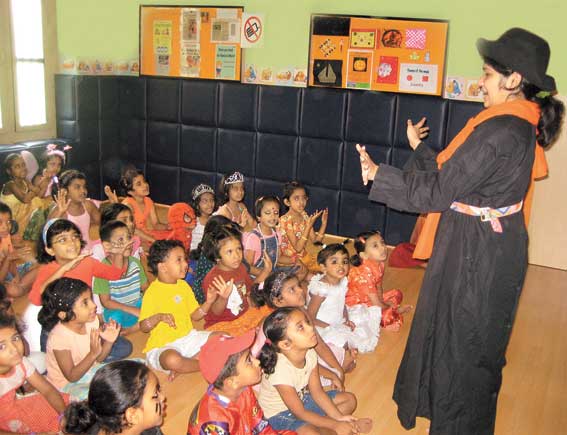Manaswini Sridhar
I teach English for primary school children. I read to them occasionally. I have never done much loud reading before, so I would like a few tips on how to manage my class and my book when I am reading to these little ones. I would like the class to be involved with the book.
Reading a story is a wonderfully creative way of educating and entertaining your students. It is invigorating not only for the students, but also for you, especially if you have just completed a 40-minute intense subject-oriented session.

Don’t make the mistake of casually picking up any story and reading it. No matter how seasoned a storyteller or reader you are, you need to be familiar with the language of the story and the characters before reading it to an audience. You have to do this in order to breathe life into the story. Voice modulation, intonation and the pace at which you deliver are all the interesting ways of captivating your listeners and helping them relate to the story. A child may not understand every single word, but your narration should be able to convey the overall emotion or impact of the story. Children lose interest when you read either too quickly or too slowly. Make sure that the pace is just right, and your voice shows interest, involvement and excitement.
Choose a story that suits the comprehension level of the children, not necessarily their age group or the class they are in. For stories to be appreciated, they have to be pitched correctly. For example, you cannot tell the story of The Three Little Pigs to class 7 or 8 children, and expect them to experience the same kind of enjoyment as the pre-primary or primary students. Class 7 students would have heard the story often as infants, and now they would probably consider it ‘childish’. On the other hand, the Mullah Nasruddin stories would fall flat on pre-primary students because they would be unable to appreciate the subtle humour of the situations. While younger children relate more to animal stories and sounds, older children like action, adventure, mystery and even romance!
Loosen up your body language during storytelling sessions. Do not retain the posture of the prim and proper teacher. If the story demands that you scream out loud (like the Grandmother in Little Riding Hood), do so without feeling too embarrassed. Children will love it and they will be totally involved in the situation. It may be the talk of the class, but then, that is the kind of impact you are looking for!
Allow students to sit around you and close enough so that you are able to show them the pictures in the book. This is a wonderful way of kindling their imagination. Exposure to colour is exciting for children, so do not deny them this pleasure. A child learns more from pictures than from words. Remember the saying, “A picture is worth a thousand words.” Make sure there are plenty of colourful pictures in the book to make up for their limited vocabulary in certain cases. Hold the book a little away from you and at chest level so that students can study your facial expressions as you read.
Mime whenever and wherever you think necessary. Change your voice and tone to suit your characters. For children of lower classes, make sure that the story does not revolve around too many characters, making it complicated and tedious for them to follow. The plot must be simple and single. Eye contact with all the children is necessary so that they feel totally involved and included in the reading. Sometimes you could pause and throw questions to them, such as –
What did Piggy see?
Which house was the strongest?
 Responses from the listeners are a reassurance to the teacher that she is audible and that her listeners are able to follow the story. Allow children to interrupt you and ask questions. Do not smother their questions or interests as you would in a subject-oriented class where you think such questions are mere digressions. Children can colour while you read, and still be able to capture your story. Let them be relaxed and comfortable so that the story and the environment are relaxing.
Responses from the listeners are a reassurance to the teacher that she is audible and that her listeners are able to follow the story. Allow children to interrupt you and ask questions. Do not smother their questions or interests as you would in a subject-oriented class where you think such questions are mere digressions. Children can colour while you read, and still be able to capture your story. Let them be relaxed and comfortable so that the story and the environment are relaxing.
A final word of caution: Use stories as a means of entertainment; do not make it tedious by using a story merely as a means of teaching your subject. At times, children learn more from entertainment than from instruction. Above all, storytelling develops their listening skills in a way that nothing else can. Teachers who read with excitement are in many ways responsible for fostering the reading habits of children.
Include songs and rhymes in your storytelling sessions. You will soon find that children are willing to complete their tasks quickly so that they make time for you to read a story!
The author is a teacher educator and language trainer based in Chennai. She can be reached at manaswinisridhar@gmail.com.
